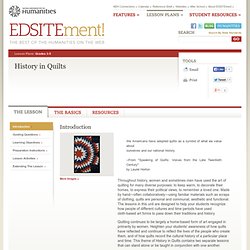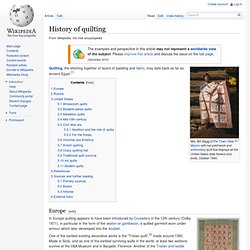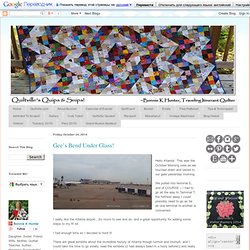

Barbara Brackman's MATERIAL CULTURE. Textiles — CHRISTOPHER PAYNE. National Quilt Collection. "Quilt": A cover or garment made by putting wool, cotton or other substance between two cloths and sewing them together.

An American Dictionary of the English Language, by Noah Webster, LL.D., New York 1828. The National Quilt Collection incorporates quilts from various ethnic groups and social classes, for quilts are not the domain of a specific race or class, but can be a part of anyone’s heritage and treasured as such. Whether of rich or humble fabrics, large in size or small, expertly crafted or not, well-worn or pristine, quilts in the National Quilt Collection provide a textile narrative that contributes to America’s complex and diverse history. The variety and scope of the collection provides a rich resource for researchers, artists, quilt-makers and others. America's Quilting History, Quilt Styles and Quilting Myths.
Travel from Colonial times through the Civil War and theVictorian era up to the 20th century quiltmaking revival.

Including the styles that you expect like Baltimore Albumand Crazy Quilts and others that will surprise you. Native American, Black American, Mexican American Hawaiian, Hmong & Amish quiltmaking history. Themes and methods through time including Bible, temperance, feedsack and kit quilts. Discover how researchers have separated fact from myth.The truth can be more interesting than fiction. Links to resources and a search of selected sites. Needlework & Quilt History - Making Reproduction Quilts. Why Quilts Matter: History, Art & Politics - Welcome. History of Quilts. Throughout history, people have enjoyed quilts for many different reasons.

Quilts can provide clues to the past. Quilts can provide warmth. Quilts can provide beauty and value. Quilts can provide heritage. Quilting in America.pdf. History in Quilts. Activity 1.

An Introduction to Historical Quilts If possible, center this lesson around one or more authentic quilts in the classroom, to give students the opportunity to see how a quilt is constructed (the stitching, squares, stuffing and so on). How is a quilt different from a blanket? It is like two blankets sewn together with padding in between. The stitching that keeps the padding in place creates a pattern that invites further decoration. Quilt Pattern Spotlight: Double Nine Patch.
History of Quilting - Center for Great Plains Studies. Julie Johnson Random House Dictionary defines a quilt as "a coverlet for a bed, made of two layers of fabric with some soft substance, as wool or down, between them and stitched in patterns or tufted through all thicknesses in order to prevent the filling from shifting.

" The word quilt comes from the Latin culcita meaning a stuffed sack, but it came into the English language from the French word cuilte. The origins of quilting remain unknown, but historians do know that quilting, piecing, and applique were used for clothing and furnishings in diverse parts of the world in early times. History of quilting. Mrs.

Bill Stagg of Pie Town, New Mexico with her patchwork and embroidery quilt that displays all the United States state flowers and birds, October 1940. Quilting, the stitching together of layers of padding and fabric, may date back as far as ancient Egypt.[1] Europe[edit] History of Quilts. The history of quilts began long before European settlers arrived in the New World.

People in nearly every part of the world had used padded fabrics for clothing, bedding, and even armor. With the arrival of the English and Dutch settlers in North America, quilting took on a new life and flourished. The term "quilt" comes from the Latin <i>culcita</i>, meaning a stuffed sack. The word has come to have 2 meanings. Hispanic Quilts & Quilting: Mexican Color & Spanish Needlework. We tend to think of Mexican-Americans as immigrants but Southwestern history tells another story.

We discover that people from Spain and Mexico lived in what is now United States well before anyone else but the Native Americans. From Looking for Gold to Sheepherders in Need of Grassland It all began with Coronado looking for gold in 1540. By the 17th century there were settlements in what is now New Mexico. Gee’s Bend Under Glass! Hello Atlanta!

This was the October Morning view as we touched down and taxied to our gate yesterday morning. We pulled into terminal E, and of COURSE – I had to go all the way to Terminal T, the furthest away I could possibly need to go as far as one terminal to another is concerned. I really like the Atlanta airport…So much to see and do, and a great opportunity for adding some steps to my fit bit.
I had enough time so I decided to hoof it! Bringing you outstanding sewing, quilting, and needlework tutorials since 2005. I usually don’t blog about myself or my experiences.

I’m as shy online as I am in real life, so I sometimes break a sweat when I have to reveal. On rare occasions, however, I do like to go on about things I find important. Despite my current career of luxury in which I putz around on the internet and buy fabric by the bolt, I still consider myself an educator at heart and learning and teaching are a couple of things that I like to talk about. Quilt Blocks. According to Ozella Williams, an African American woman who lives in South Carolina, tells the story that her mother told her about the Underground Railroad Quilt Code. Apparently, there were ten quilts used to direct slaves to take particular actions. Fibonacci and the Golden Ratio. A few blog posts ago, when I talked about the Golden Ratio, (1 to 1.618 or .618 to 1) there were several questions about how the golden ratio relates to the Fibonacci number sequence.
Leonardo Fibonacci was an Italian mathematician (c. 1170-1250) who devised a number sequence where the relationship of one number to the next or previous one provided perfect proportions. Mathematicians and artisans have been using this number sequence ever since. Some quilters use these numbers to plan proportion for their designs.
Quilt University » Online Quilting Classes. Quilting 101 - Quilt making tips and resources. START HERE! Are you new here? Hi! Welcome to the Free Motion Quilting Project! I’m sure you have a lot of questions about what this project is, how it works, why I created it, and where to get started, so the easiest thing was just to make a video explaining it all in one go: Click Here if the Video Does Not Appear Tip: If any video on the project stops playing try clicking “pause” and allow the little red bar at the bottom to fill up completely before hitting “play” again.
The Quilt Index. Block Central's Quilt Directory Find Free Quilt Patterns and Information. "By luck, I stumbled upon your site, and of course I wanted to try it out. I went on to deposit $500 on OneTwoTrade, then opened 5 positions and won 4. Took out the $500 and still have the profit of $288 to trade with. This is a great system you got there Sir, I definitely owe you one.
" Shelly Green - New York "I began with $200 on OneTwoTrade and I went down to $100 the first day. John Bates - Los Angeles. American Quilter's Society - Home - Quilt Shows & Contests, Workshops, Books & Magazines. The National Quilt Museum. The National Quilting Association. The Art of Quilting. The Modern Quilt Guild. International Quilt Association. Quilting Board. Joannm.champtal. Womenfolk: The Art of Quilting: Patterns & History. Quilt History - A short introduction to period quilting. By Lady Sarah Davies c/o Karen Evans 5 Deerfield Drive Easthampton, MA01027 aol.com The word "quilt" summons a host of images: thrifty pioneer housewives piecing elaborate patchworks for their families; album quilts signed by every member of a community as a gift for a departing mayor or pastor, or perhaps raffled for a worthy cause; perhaps even a wholecloth petticoat worn by a colonial dame as she danced with George Washington, or a brightly colored scrap quilt made by a grandmother or aunt during the Depression.
The popular image of the quilt is of the quilt is modern, calico, and American. It certainly isn’t medieval! The problem with this familiar stereotype is that it doesn’t go far enough. Quilting may have reached its apogee in the glorious appliqued quilts of 19th century Baltimore, but it was practiced nearly two thousand years earlier. A Thing Of Beauty in the Pennsylvania Dutch Country. Amish women of the Pennsylvania Dutch Country have been creating exquisite Amish quilts since the mid-1800′s (and some believe even earlier). Quilt History.
Needlework & Quilt History - Making Reproduction Quilts. America's Quilting History, Quilt Styles and Quilting Myths.